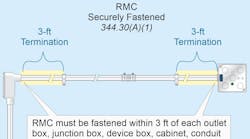Q. What are the requirements related to the use of a ground rod for the grounding electrode system, including sizing of the grounding electrode conductor? (Answer based on 2011 NEC.)
A. Ground rod electrodes must not be less than 8 ft in length in contact with the earth [250.53(G)]. Rod-type electrodes must have a diameter of at least 5/8 in., unless listed [250.52(A)(5)(b)]. Rod, pipe, or plate electrodes must meet the following requirements [250.53(A)]:
1) If practicable, rod, pipe, and plate electrodes must be embedded below the permanent moisture level and be free from nonconductive coatings such as paint or enamel.
2) A single rod, pipe or plate electrode must be supplemented by an additional electrode that’s bonded to one of the following:
- The single rod, pipe, or plate electrode
- The grounding electrode conductor of the single electrode
- The neutral service-entrance conductor
- The nonflexible grounded service raceway
- The service enclosure
Exception: If a single rod, pipe, or plate grounding electrode has an earth contact resistance of 25 ohms or less, the supplemental electrode isn’t required.
The grounding electrode conductor, if it’s the sole connection to the ground rod, isn’t required to be larger than 6 AWG copper [250.66(A)]. In addition, the diameter of a ground rod has an insignificant effect on the contact resistance of a ground rod to the earth. However, larger diameter ground rods (¾ in. and 1 in.) are sometimes installed where mechanical strength is desired, or to compensate for the loss of the electrode’s metal due to corrosion.



